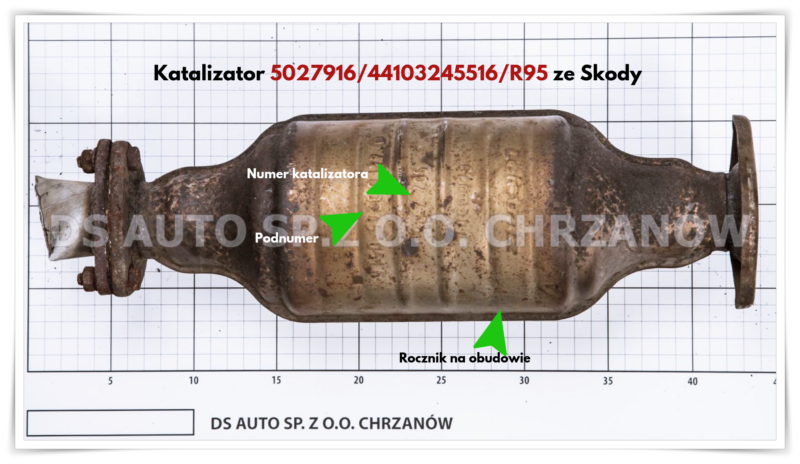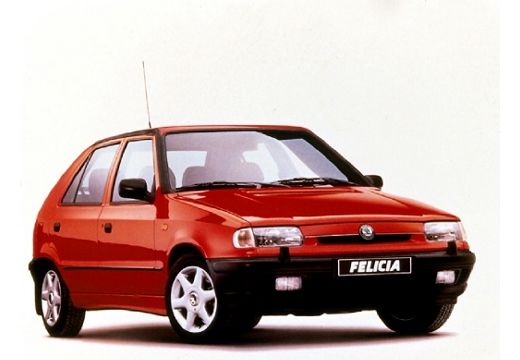Catalysts with the number 5027916/44103245516/R95 are used by Skoda to manufacture car catalytic converters. This model measures about 44 cm in length, and the weight of the cartridge is 0.985 kg. They are characterized by a symmetrical structure, flattened edges, transverse stripes in the place of the installed insert and bilateral narrowing at the outlets. They are often affected by corrosion, but the numbers are usually easy to read. This model is on sale in September 2019.
They were mounted in cars Skoda Felicia 1.3 in the gasoline version of 1995.

Skoda Felicia was installed in the years 1994–2001 by a Czech company Skoda Auto. The model was produced as a five-door hatchback and a five-door station wagon for everyday, urban use.
It was developed partly on paper and partly on a computer.
It was a model in which the integration of the manufacturer with the German one was strongly reflected Volkswagen Group, for example, by entering the appropriate production specification. Conceptually, the car was based on the previous Skoda Favoit model, but its design was more advanced. The model is equipped with a whole range of improved engines. Compared to the Favorit model, new versions have introduced new features such as ABS, power steering, etc.
The name Felicia was adopted from the previous sports model Felicia produced in the 1960s in a version with a fixed or folding roof.

The variants were marked according to the abbreviations of the equipment LX, LXi, GLX, GLXi, and the letter “i” meant a 1.3-liter, 50 kW engine.
The model was developed partly on paper and partly on a computer. The development of the hatchback body began in 1991, and the first test series was produced a year later.
A verification series was produced in 1993, and serial production began on September 5, 1994. At the same time, the development of Kit-Car racing cars with engine capacities up to 1300 and 1500 cm³ began. Utility versions have been produced since 1995, when production replaced models based on Favorit. Hatchback and station wagon cars were produced in Mladá Boleslav until 2000, when production was moved to Kvasin.
The Hatchback was presented to the public in October 1994 in Prague, and in June 1995, at the Brno Motor Show, the station wagon variant was shown. The Pickup variant has also been produced since 1995. In 1998 a facelift was carried out. The shape of the radiator grille, the color and shape of the bumpers were changed (from black to the color of a specific car, later the color of the door handles and mirrors), the Felicia inscription at the rear, and the shape of the headlights and fog lights. Production was discontinued on June 20, 2001. A total of 1 420 441 copies were produced. The successor of the model was Škoda Fabia. In Kvasiny, where the model was produced until the end of the series, the line was rebuilt to produce the Skoda Superb. Ten years after the end of production, Felicia was still the busiest car on Czech roads.
Felicia and Favorit were important cars for Škoda, because their sale gave designers time to develop modern cars under the baton Volkswagen.
According to Felicia owners, it is a grateful, simple and easy to maintain car. Its biggest advantage is that it doesn’t have any expensive, modern parts that could increase its servicing costs. Assuming an LPG installation, it is extremely cheap to maintain. The model is known for reliable, trouble-free engines.
It has no safety systems or power steering, which can be burdensome on long journeys. The biggest problem, however, is the ubiquitous rust and poor soundproofing, which can be felt at higher speeds. However … something for something.

 Phone number:
Phone number:  E-mail:
E-mail:  A stationary point:
A stationary point:  Getting from the customer:
Getting from the customer:  XRF analysis spectrometer:
XRF analysis spectrometer:  Valuation by numbers:
Valuation by numbers: 